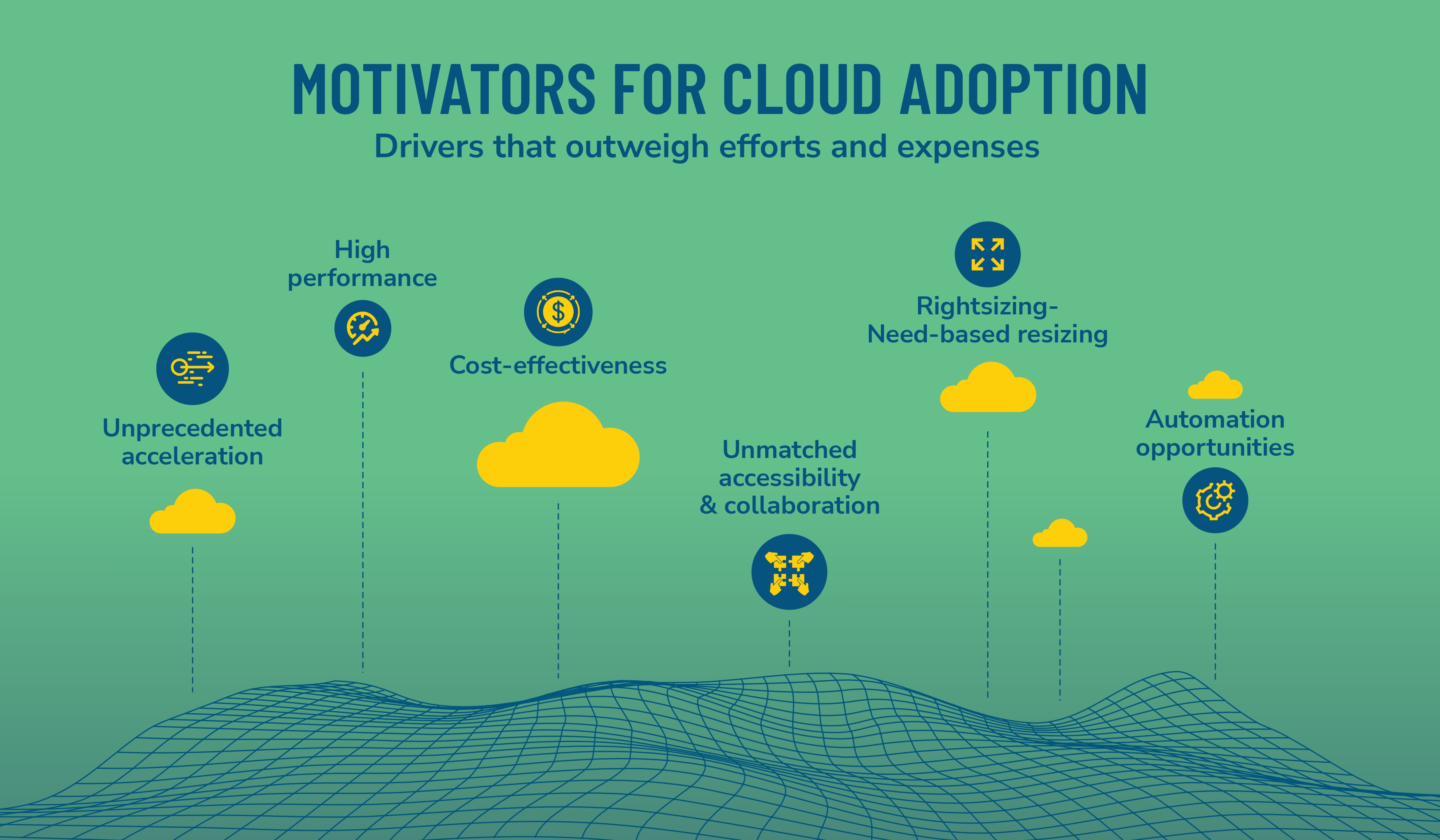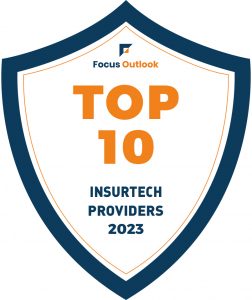Digital transformation projects stem from the need and aspiration of businesses for innovation. These projects target greater scalability, agility, adoption of modern security methods, and leveraging new capabilities. In the present day and age, the cloud is the force multiplier for such transformations. It establishes the foundation for next-generation IT capabilities and paves the way for innovation and business growth.
Businesses realize the power of cloud computing—94% of the enterprises use cloud services, with 67% having a cloud-based infrastructure—however, many struggle to derive the absolute value of their migration efforts.
One of the prime reasons for this struggle is rushing to move the entire enterprise system without defining a holistic strategy for cloud adoption. An article published by Mckinsey rightly explains the reason for these exasperations.
“This is because companies tend to fall into the trap of confusing simply moving IT systems to the cloud with the transformational strategy needed to get the full value of the cloud. Just taking legacy applications and moving them to the cloud—”lift-and-shift”—will not automatically yield the benefits that cloud infrastructure and systems can provide.”
Due to injudicious and hurried movement to clouds, businesses can end up with complex, unproductive, and costly IT infrastructure.
Table of Contents
Why does “lift-and-shift” not work?
Cloud platforms offer pay-as-you-go, usage-based upscaling and downscaling, self-service, resilience, and many more. With these features, businesses assume enhanced service quality, significant cost reduction, and faster time-to-market.
As dreamy as that may sound, two obstacles are the biggest party popers.
- Applications developed in traditional IT environments are bulky and primarily monolithic. Such monolithic applications are often designed to run on a single server or cluster of servers and are usually difficult to scale or modify. They may rely on specific hardware or software configurations, making it difficult to move to a new environment without making significant changes to the application. Furthermore, moving the application to a new environment without making changes to the application can result in compatibility issues and decreased performance.
- The workforce developing and operating traditional applications needs upskilling or reskilling for efficient cloud operations.
For instance, traditional IT infrastructures have a “castles-and-moats” style of security focused on protecting perimeters. Contrarily, the widely and remotely accessible cloud ecosystem is susceptible to many sophisticated threats. Traditional applications need major reconfigurations to adapt to new security models and fight their adversaries.
As a result, most businesses get stuck between an inefficient, traditional system and inadequately strategized cloud adoptions.
SaaS solutions provide a more straightforward way to accomplish cloud implementations. The SaaS providers take all the responsibility for replacing existing applications and developing new features.
Why are enterprises adopting cloud computing – Benefits and new capabilities
Cloud computing underpins every business model. While most large-scale enterprises choose to migrate for monetary benefits, the cloud offers boundless growth possibilities.
 Cloud capabilities open new opportunities, drive innovation, and deliver benefits that make companies resilient, progressive, and future-ready. The following are some of the promising possibilities.
Cloud capabilities open new opportunities, drive innovation, and deliver benefits that make companies resilient, progressive, and future-ready. The following are some of the promising possibilities.
Acceleration
According to the Boston Consulting Group (BCG), cloud enables large companies to roll out their services 30% to 60% faster than their customized built-in infrastructure. Lead times can come down to minutes from months.
Cloud-based development methods such as Agile and DevOps dramatically accelerate the development and deployment of services and functionalities.
High performance
With effective cloud adoption, large enterprises improve their service delivery by 25% to 50% and free up staff for more business critical requirements, says BCG. Cloud vendors offer almost instantaneous provisioning of resources.
Equipped with the latest technology, they provide highly reliable and scalable functionalities, greater automation, and high-level services, all ingredients to high performance.
Greater cost-effectiveness
Returns v/s Investments are a dominant decision driver for many CIOs. While many are apprehensive about it, businesses can save 15% to 36% by moving to the cloud.
Enterprises can gain more from cloud adoption than their cost by comprehensively considering employee productivity, time-to-market, innovations, enhanced business, and other factors.
Unmatched accessibility and collaboration
Cloud adoption propels individual performances and team capabilities. Extreme networking brings the entire world to workstations. It enables employees to collaborate on projects and share data from remote locations. They also get access to real-time updates on the go that further proliferates their productivity.
Resizing, right-sizing based on needs to AI based monitoring and scaling
Why establish and maintain a massive static infrastructure when you can expand or shrink as per requirements? Cloud adoption models allow businesses to acquire or decommission resources—processors, memory, storage, and others—based on their current needs. Cloud vendors also provide AI-based monitoring tools to streamline resource tracking.
Opportunities for automation
With abundant automation opportunities, from Infrastructure-As-Code at the server level to Low Code / No Code recipes for the app owners and developers the cloud is becoming the core of digital-first business models. Cloud vendors provide automation tools for every critical operational aspect, from backups to code practices, version control, and user-access control.
Selecting the right cloud service provider(s) and Tools
Selecting the right cloud service provider(s) and tools is crucial for businesses aiming to leverage the benefits of cloud adoption. When it comes to choosing a cloud service provider, industry leaders such as Amazon Web Services (AWS), Microsoft Azure, and Google Cloud Platform (GCP) are often preferred for their comprehensive features, scalability, and reliability. Additionally, selecting the right testing tools such as Microsoft Azure DevOps, Amazon AWS Device Farm, CloudTest by SOASTA, WebLOAD by RadView, and Micro Focus LoadRunner (earlier HP) offer comprehensive solutions for testing the performance, security, and functionality of applications deployed on the cloud.
Additionally, migration tools like AWS Server Migration Service, Azure Migrate, and Google Cloud Migrate offer efficient and secure methods for migrating applications, databases, and data to the cloud, minimizing downtime and maximizing productivity.
Align cloud-based modernization with business goals to increase revenue and enhance margins
Cloud investment priorities vary in different domains. It also varies based on consumption models, including app maturity, infrastructure maturity, KPIs, and other factors with an organizational IT domain. In any case, it is imperative to align modernization investments with business goals and ensure profitability.
 One way to achieve that is by focusing on composability and reusability. It allows companies to scale their investments across the remaining organization sections and divert efforts towards the more beneficial areas. Some such areas are
One way to achieve that is by focusing on composability and reusability. It allows companies to scale their investments across the remaining organization sections and divert efforts towards the more beneficial areas. Some such areas are
- Accelerated cloud adoption for faster time to market: Automated cloud platforms allow enterprises to release new features daily. It rapidly tests capabilities and enables quick responses to market demands.
- Creating innovative business offerings: Cloud platforms offer thousands of native services. Third-party ecosystems provide many more. All these services keep evolving and deliver advanced functionalities such as face recognition, data aggregation, and more.
- Risk reduction: Cloud adoption delegates the opportunities to relinquish most operational overheads to the platform designers, who make cloud consumption more secure. They incorporate robust, standardized authentication, resilient data center interconnectivity, and other built-in tolerances, around recovery, backups, and platform resiliency.
- Efficient scaling ability coupled with decreased costs: Cloud adoption enables automation scaling to address sudden demand surges. Companies can scale out new services in minutes, which would take weeks in traditional infrastructure owing to higher resource procurement time. This leads to decreased costs and ensures a more predictable costing for infrastructure.
Kumaran’s assessment-intensive approach to cloud-based digital transformation
Cloud-based digital transformations are high-stake projects. While cloud vendors and automation tools streamline the process, diligent and extensive assessment is the key to a successful transformation journey.
 Kumaran advocates a detailed assessment of existing applications and the project’s scope to be quintessential to draw maximum cloud adoption benefits. The following are valuable evaluations that enterprises must adopt early in embracing the cloud for their next-generation infrastructure.
Kumaran advocates a detailed assessment of existing applications and the project’s scope to be quintessential to draw maximum cloud adoption benefits. The following are valuable evaluations that enterprises must adopt early in embracing the cloud for their next-generation infrastructure.
- Existing IT portfolio: Look at the existing application portfolio to determine its suitability for the cloud shift.
- Transformation approach: All stakeholders collaboration approach to choose the transformation approach (any choice or mix of choices of the 6R approaches). This selection governs almost all other business/project-critical decisions.
- Business goals and project results: Business leaders must diligently define project aspirations and desired derivatives. They must ensure aligning the desired results with the overall business objectives.
- Available buy-ins: Transformation calls for unwavering determination from the topmost leaders and active participation of senior management in the form of executive championship. It mainly requires finance leaders to support the investment needs continually.
- Internal friction and change management: Transforming to cloud-based agile operations demands significant behaviour and mindset shift. Enterprises must invest in managing change and developing appropriate skills throughout the application and security environments.
- KPIs: Identify the performance indexes to evaluate the performance of applications. It helps validate the results and keep the project on track throughout the journey.
Exhaustive and careful assessment lays the foundation of a successful transformation project. It enables better infrastructure management, high service levels, and quick rollouts.
Here are some advantages of following a precisely deliberated cloud adoption approach.
- Reduced operational costs and IT overheads
- Optimized usage of IT assets by scaling up and down as required
- Meeting business needs with frequent feature releases and being current with the market and industry trends.
- Enhanced service quality by using the cloud solution’s self-healing nature.
- Performance-based cloud allocation that delegates capabilities according to the number of transactions and performance requirements of applications. Auto load balancers deliver efficient elasticity for both horizontal and vertical scaling.
Common pitfalls to avoid while modernizing
Although digital transformation with cloud adoption has become the new way of business, only a few succeed fully. Kumaran identifies the prevalent shortcomings that result in most failures.
- Inadequate assessment: It often leads to poor design and improper implementation. A system or application that is not ready for the cloud yields no ROI; instead, it elevates the cost in most cases.
- Unclear objectives: Identifying the right cloud adoption transformation approach with clear milestones and well-defined KPIs for measuring outcomes is implausible without clear goals.
- Procrastinating governance incorporation: Security, control, and compliance are all basic cloud adoption requirements, and governance underpins them. Enterprises must embrace it early and incorporate any feedback in the iterative process to ensure compliance.
- Ignoring culture and change management: Transformation projects call for intensive collaboration, learning, and relearning. Workforces often have to let go of their conventional ways of working. Engagement, support, and commitment of leaders and active participation of users at all levels are crucial for its success.
- Inadequate budgeting: Digital transformation is an ongoing process. Budgeting must consider unexpected risks and costs to avoid project derailing.
- Skipping scaling up strategy beyond pilot: Working on broader cross-sections is much different from executing pilots. It requires thinking through leadership bandwidth, resource constraints, and the organization’s overall readiness before hitting the road.
Digital Transformation without cloud adoption is unthinkable
Markets are uncertain. People are demanding. In a VUCA world businesses must be responsive. Scalability, flexibility, and resilience are the need of the hour, making cloud adoption a new mandate for digital transformation.
Cloud adoption expands on every new business opportunity by increasing cost-savings, and innovation.
Kumaran Systems excels in synchronizing legacy and modern systems and building resilient business models. Contact us for a cloud readiness assessment using the help of our industry specific domain experts in this field.



